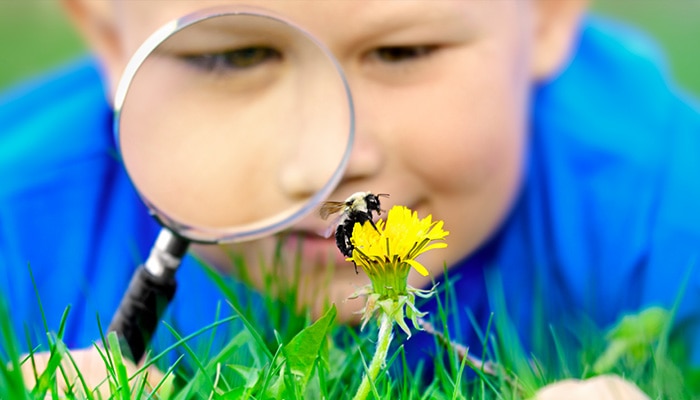While we believe that the books and resources recommended may be of value to you, keep in mind that these are suggestions only and you must do your own due diligence to determine whether the materials are appropriate and suitable for your use. PNC has no sponsorship or endorsement agreement with the authors or publishers of the materials listed.
CURIOUS CRAWLERS

How Do Insects Eat?
Children will investigate how insects eat.

Lesson Objective
Children will investigate how different insects eat by experimenting with tools that are similar to insects’ mouths.
Science
What You'll Need
- Pictures of the mouths of an ant, bee, and fly (available online)
- Empty juice container, cereal box, and applesauce container with labels attached – 1 of each
- Child-size tweezers – 1 per child in small group
- Straws – 1 per child
- Sponges – 1 per child
- Thick glue, paste, or paint – 1 container
- Colored water – 2 cups
- Aquarium gravel – 2 cups
- Disposable bowls – 1 per child, plus 3 more (bowls)
- Paper towels – 1 roll
What To Do
Note: This activity uses non-food items to avoid food-related concerns in some classrooms. This lesson will be completed in two parts; Part 1 is with the whole group, and Part 2 is in small groups. Place the empty juice container behind a cup filled with colored water, the cereal box behind a bowl of aquarium gravel, and the applesauce container behind a bowl of glue (paste or paint) prior to the start of the lesson. Refill as needed.
Whole Group:
1. Display the pictures of the insects’ mouths. Explain the different insect mouths and the different ways insects draw food into their mouths (see Did You Know?).
2. Display the various tools (tweezers, straws, sponges) and discuss how the tools are similar to the insects’ mouths. Match each tool to each type of insect mouth (see Did You Know?).
3. Divide the children into small groups, and tell them they will each get a turn to use the tools.
Small Group:
4. Distribute 1 bowl, tweezers, a straw, and a sponge to each child.
5. Tell them to pretend the bowl is the insect’s stomach and they will use tools to fill the insect’s stomach.
6. Explain that the colored water is thin like juice, aquarium gravel is chunky like cereal, and the glue (paste/paint) is thick like applesauce.
7. Demonstrate using the straw by placing it in water and putting your finger over the opposite end of the straw, and then release the water onto a paper towel.
8. Allow the children to try using tweezers, sponges, and straws to move the materials into their insect’s stomach (bowl).
9. Discuss which instruments worked best for the different materials. Have children explain the difficulties they encountered picking up the materials with the various instruments.
Resources
Home School Resources
Home educators: use these printable lesson PDFs to teach this lesson to your home schoolers. They're available in English and Spanish.
Content Provided By
Common Core State Standards Initiative – These lessons are aligned with the Common Core State Standards ("CCSS"). The CCSS provide a consistent, clear understanding of the concepts and skills children are expected to learn and guide teachers to provide their students with opportunities to gain these important skills and foundational knowledge [1]. Visit the CCSS


